乘坐交通工具的表达方式
- 格式:ppt
- 大小:4.97 MB
- 文档页数:12
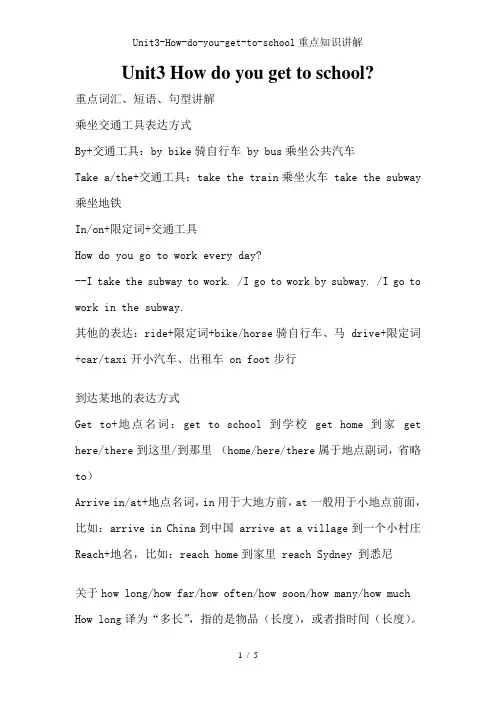
Unit3 How do you get to school?重点词汇、短语、句型讲解乘坐交通工具表达方式By+交通工具:by bike骑自行车 by bus乘坐公共汽车Take a/the+交通工具:take the train乘坐火车 take the subway 乘坐地铁In/on+限定词+交通工具How do you go to work every day?--I take the subway to work. /I go to work by subway. /I go to work in the subway.其他的表达:ride+限定词+bike/horse骑自行车、马 drive+限定词+car/taxi开小汽车、出租车 on foot步行到达某地的表达方式Get to+地点名词:get to school到学校 get home到家 get here/there到这里/到那里(home/here/there属于地点副词,省略to)Arrive in/at+地点名词,in用于大地方前,at一般用于小地点前面,比如:arrive in China到中国 arrive at a village到一个小村庄Reach+地名,比如:reach home到家里 reach Sydney 到悉尼关于how long/how far/how often/how soon/how many/how much How long译为“多长”,指的是物品(长度),或者指时间(长度)。
当询问时间时,其答语为:About/For+一段时间。
How long does it take to get to school? --About 15 minutes. How long is this ruler? --About 20 centimeters.How far译为“多远”,指的是路程距离的远近。
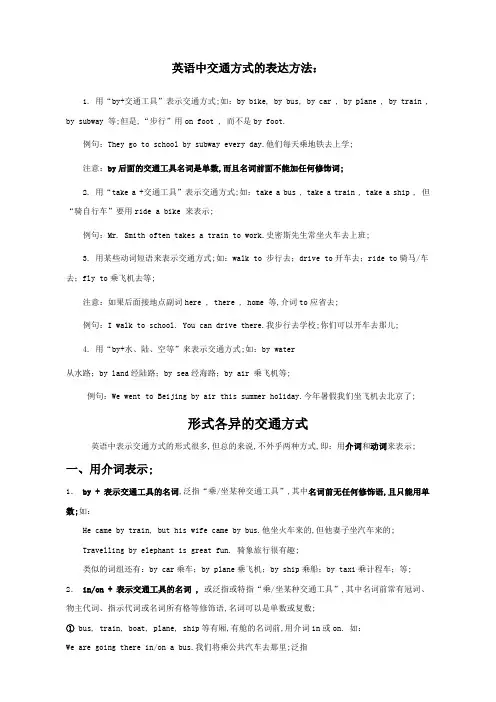
英语中交通方式的表达方法:1. 用“by+交通工具”表示交通方式;如:by bike, by bus, by car , by plane , by train , by subway 等;但是,“步行”用on foot , 而不是by foot.例句:They go to school by subway every day.他们每天乘地铁去上学;注意:by后面的交通工具名词是单数,而且名词前面不能加任何修饰词;2. 用“take a +交通工具”表示交通方式;如:take a bus , take a train , take a ship , 但“骑自行车”要用ride a bike 来表示;例句:Mr. Smith often takes a train to work.史密斯先生常坐火车去上班;3. 用某些动词短语来表示交通方式;如:walk to 步行去;drive to开车去;ride to骑马/车去;fly to乘飞机去等;注意:如果后面接地点副词here , there , home 等,介词to应省去;例句:I walk to school. You can drive there.我步行去学校;你们可以开车去那儿;4. 用“by+水、陆、空等”来表示交通方式;如:by water从水路;by land经陆路;by sea经海路;by air 乘飞机等;例句:We went to Beijing by air this summer holiday.今年暑假我们坐飞机去北京了;形式各异的交通方式英语中表示交通方式的形式很多,但总的来说,不外乎两种方式,即:用介词和动词来表示;一、用介词表示;1.by + 表示交通工具的名词,泛指“乘/坐某种交通工具”,其中名词前无任何修饰语,且只能用单数;如:He came by train, but his wife came by bus.他坐火车来的,但他妻子坐汽车来的;Travelling by elephant is great fun. 骑象旅行很有趣;类似的词组还有:by car乘车;by plane乘飞机;by ship乘船;by taxi乘计程车;等;2.in/on + 表示交通工具的名词 ,或泛指或特指“乘/坐某种交通工具”,其中名词前常有冠词、物主代词、指示代词或名词所有格等修饰语,名词可以是单数或复数;① bus, train, boat, plane, ship等有厢,有舱的名词前,用介词in或on. 如:We are going there in/on a bus.我们将乘公共汽车去那里;泛指Don't come here on /in the ship. 不要坐船来这里;特指② bike或motorbike前,只能用介词on. 如:They go to work on their bikes.他们骑自行车上班;特指She went out on her new motorbike. 她骑着她的新摩托车出去了;特指③ car,taxi前,多用介词in. 如:We are going to France in John’s car.我们将坐约翰的车去法国;特指3.by/on + 表示交通工具的名词,特指“乘/坐某一趟/辆/艘车,船等”,其中名词为单数,其前常有定冠词与数词或具体时刻一起作修饰语;如:They came here by/on the first bus.他们是坐头班车来的;You can get there by/on the Number 10 bus / bus . 你可以乘10路公共汽车到那里;He went up to London by/on the 10:30 train. 他是乘10时30分的火车去伦敦的;4.by + 表示交通工具的名词,泛指“乘/坐某种档次的交通工具旅行”,其中名词为单数,其前常有表示“等级或档次”的形容词作修饰语;如:She travels by third-class train. 她乘三等车旅行;I will go to Beijing by the fast train. 我将乘快车去北京;He flew to Paris by first class plane. 他坐头等舱飞往巴黎;He went to Tokyo by a large ship.他乘一艘大船去了东京;5.by + 表示交通线路或交通线路所经范围的名词,表示“经由陆路/水路/空中等线路旅行或运输”,其中名词为单数或不可数,其前无任何修饰语;如:Shall we go by land or by sea 我们是由陆路去还是由水路去It saves a lot of time to travel by air. 乘飞机旅行可以节省许多时间;类似的词组还有:by water由水路;by road由公路;by rail由铁路;等;6.on + 表示人或动物特定身体部位的名词,表示“步行或骑马/骆驼”,其中名词只能是foot, horseback或 camelback, 其前无任何修饰语;如:She usually goes to school on foot. 她通常步行上学;Our friends arrived on horseback.我们的朋友是骑马到的;7.on + 表示交通工具的动物名词,表示“骑驴/马/象/骆驼”,其中名词为donkey, horse, elephant 或camel, 其前常有不定冠词a/an. 如:The old man used to go out on a donkey. 那个老汉以前都是骑驴外出的;He went there on a horse. 他骑马去了那里;类似的词组还有:on an elephant骑象;on a camel骑骆驼;二、用动词表示;1.“动词 + to + 地点名词”或“动词 + 地点副词”; 这种动词主要是walk 步行,ride骑车,drive 开车,fly乘飞机,sail乘船等;如:I usually walk to school. 我通常步行上学;We sometimes ride to school. 我们有时骑车上学;They drove to the station. 他们开车去了车站;Jack flew there last Sunday. 杰克上星期乘飞机去那里了;We sailed across the Atlantic in five days.我们乘船用了五天的时间横渡大西洋; 2.“take a/the + 表示交通工具的名词”,表示“乘/坐……”;如:Will you take a bus to go there 你乘汽车去那儿吗I took a taxi to the hospital. 我坐计程车到医院去了;Tom often takes the train to go to work. 汤姆常坐这趟火车上班;类似的表达还有:take a ship乘轮船,take a plane乘飞机等;3.“ride a/an + bike,motorbike或表示交通工具的动物名词,表示“骑……”;如:I ride a bike to work every day. 我天天骑自行车上班;He came here riding a horse /an elephant. 他骑马/象来到了这里;4.“ride on/in + a/an + 表示交通工具的名词”,表示“乘/坐/骑……”;如:She gets sick when she rides in/on a bus. 她坐公共汽车时晕车;The boy liked to ride on a motorbike.那男孩喜欢骑摩托车;He often rides on an elephant to travel. 他常骑象旅行;类似的表达还有:ride in/on a ship/train/plane/boat等;辨析ride a bike着重动作;ride in/on a bike着重状态;5.“have/take a ride in/on + 表示交通工具的名词”,表示“乘/坐/骑一下/次……”;如: Would you like to have/take a ride in my new car 你要不要坐坐我的新车Can I have/take a ride on your bike 我能骑一下你的自行车吗He let me have/take a ride on his camel. 他让我骑了一下他的骆驼;6.“go for a ride in/on + 表示交通工具的名词”,表示“乘/坐/骑……去兜风”;如:They went for a ride on their horses/bicycles.他们骑马/自行车去兜了一圈;Let’s go for a ride in the car/a car ride. 我们乘汽车去兜风吧;I went for a ride on my horse before breakfast. 早餐前我骑马出去遛了遛;巩固练习:I. 用by, in, on, take填空;1.—How do you go to school every day—____ bike.2.They will go to the cinema____ bus.3.He went to the park____ a car yesterday.4.Helen will go there____ the 12:00 bus.5.Will you____ the bus to Beijing tomorrowII. 就划线部分提问;1.Mr Green goes to the post office by bike.对划线部分提问2.Ann is going shopping on foot.对划线部分提问Keys:I: 1.By 2.by 3.in 4.on /by 5.TakeII: 1. How does Mr. Green go to the post office2. How is Ann going shopping出门在外,谁也离不开交通;水、陆、空,路路通,交通可是很方便哟不过,你可要学会灵活选用交通方式,不然,就不能准时到达目的地;下面为同学们重点谈谈常见的交通表达方式:方式一用“by+交通工具名词”表示交通方式;此时交通工具的名词只能用单数,不能用复数,也不能被冠词或物主代词等修饰;如:by bike, by bus, by coach, by underground, by car, by train, by ship, by plane等;如:I came here by taxi. 我乘出租车来这儿的;We can go to the zoo by coach or underground. 我们可以乘长途汽车或地铁去动物园;Simon often goes to school by bike. 西蒙经常骑自行车去上学;方式二用“by+交通路线的位置”表示交通方式;如:by sea=by ship, by air=by plane等;如:They usually go to England by air/ plane. 他们通常乘飞机去英国;I always go to London by sea/ship. 我总是乘船去伦敦;方式三用“inon+交通工具名词”表示交通方式;此时交通工具名词前必须有冠词、名词所有格形式或形容词性物主代词等限定词修饰;如:Daniel often goes to school on a/his bike. 丹尼尔经常骑自行车去上学;Don’t come here on/in the ship. 不要坐船来这里;We go there in a car. 我们乘小汽车去那里;方式四用“take athe+交通工具名词”表示交通方式;如:take a bus, take a train, take a ship, take a plane;但“骑自行车”用ride a bike表示;“乘飞机”也可用fly to表示;“乘驾小汽车”用drive a car表示;如:Will you take a bus to go there你乘公共汽车去那儿吗Can you ride a bike to go there你能骑自行车去那儿吗We will fly to Japan next week. 下周我们将乘飞机去日本;They will drive a car to the USA. 他们将乘小汽车去美国;方式五表示“步行去某地”,可用下列两种句式:⑴go to+某地+on foot;如:She goes to work on foot. 她步行去上班;注意:on foot不可说成on feet, on a/the/my foot, by foot等;⑵walk to+某地;如:He walks to school every day. =He goes to school on foot every day. 他每天步行去上学;注意:a. walk不可与on foot连用;如上述例句不可说成:He walks to school on foot every day.b. walk to后接地点副词here, there, home时,介词to要省去;如:I usually walk home. 我通常步行回家;此外,同学们还应知道:我们在对交通方式提问时要用特殊疑问词how;如:Ann is going shopping on foot. 就划线部分提问→How is Ann going shopping。
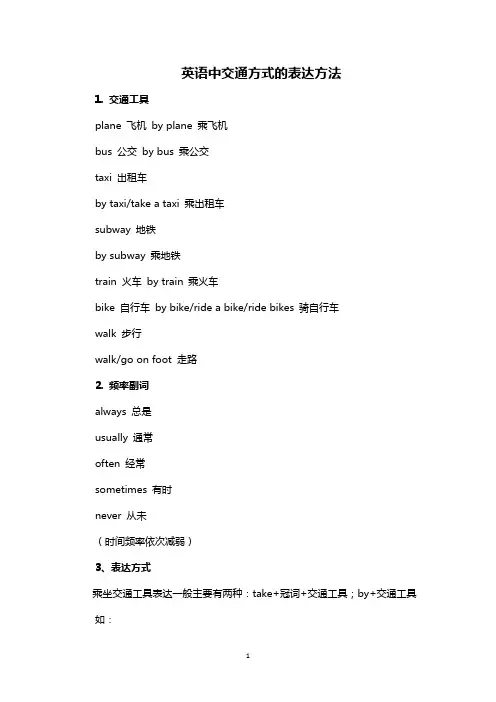
英语中交通方式的表达方法1. 交通工具plane 飞机by plane 乘飞机bus 公交by bus 乘公交taxi 出租车by taxi/take a taxi 乘出租车subway 地铁by subway 乘地铁train 火车by train 乘火车bike 自行车by bike/ride a bike/ride bikes 骑自行车walk 步行walk/go on foot 走路2. 频率副词always 总是usually 通常often 经常sometimes 有时never 从未(时间频率依次减弱)3、表达方式乘坐交通工具表达一般主要有两种:take+冠词+交通工具;by+交通工具如:坐火车by train/take a train坐飞机by air、by plane、Taking an Airplane、take a plane、Flying 步行on foot坐船by ship、take a boat、by water坐公共汽车take a bus坐汽车by car坐出租汽车take a taxi4、乘坐交通工具时常用的表达How do you get there? 你怎么去那儿?(询问出行方式)回复怎么出行的常用表达(1)I get there by bus. 我乘公交去那儿。
(2)I get there on foot. 我走着去那儿。
5、相关知识拓展随着社会文明程度的提升,很多公共设施至少在表面上人性化了,比如人行道上有盲道、大厦一楼有轮椅坡道、商场有哺乳室、公共交通工具上有“爱心专座”。
那么“爱心专座”用英文到底如何表达?其实,“爱心专座”一般有以下四种说法:(1)This is a special seat for: ...这种说法在表达上无误,图示也很清楚,不会引发误会。
但这是一种“迂回策略”,也就是“绕着弯”让人们明白这是什么,而没有直接描述“爱心专座”这个概念。
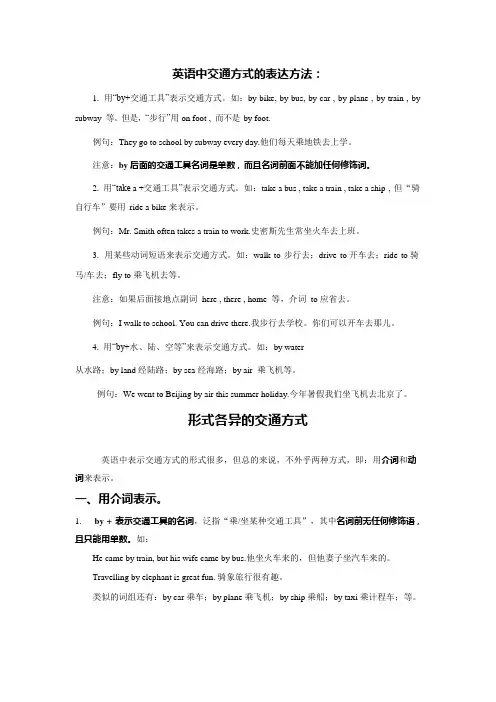
英语中交通方式的表达方法:1.用“by+交通工具”表示交通方式。
如:by bike, by bus, by car , by plane , by train , by subway 等。
但是,“步行”用on foot , 而不是by foot.例句:They go to school by subway every day.他们每天乘地铁去上学。
注意:by 后面的交通工具名词是单数,而且名词前面不能加任何修饰词。
2.用“take a +交通工具”表示交通方式。
如:take a bus , take a train , take a ship , 但“骑自行车”要用ride a bike 来表示。
例句:Mr. Smith often takes a train to work.史密斯先生常坐火车去上班。
3.用某些动词短语来表示交通方式。
如:walk to 步行去;drive to 开车去;ride to 骑马/车去;fly to 乘飞机去等。
注意:如果后面接地点副词here , there , home 等,介词to 应省去。
例句:I walk to school. You can drive there.我步行去学校。
你们可以开车去那儿。
4.用“by+水、陆、空等”来表示交通方式。
如:by water从水路;by land 经陆路;by sea 经海路;by air 乘飞机等。
例句:We went to Beijing by air this summer holiday.今年暑假我们坐飞机去北京了。
形式各异的交通方式英语中表示交通方式的形式很多,但总的来说,不外乎两种方式,即:用介词和动词来表示。
一、用介词表示。
1.by + 表示交通工具的名词,泛指“乘/坐某种交通工具”,其中名词前无任何修饰语,且只能用单数。
如:He came by train, but his wife came by bus.他坐火车来的,但他妻子坐汽车来的。
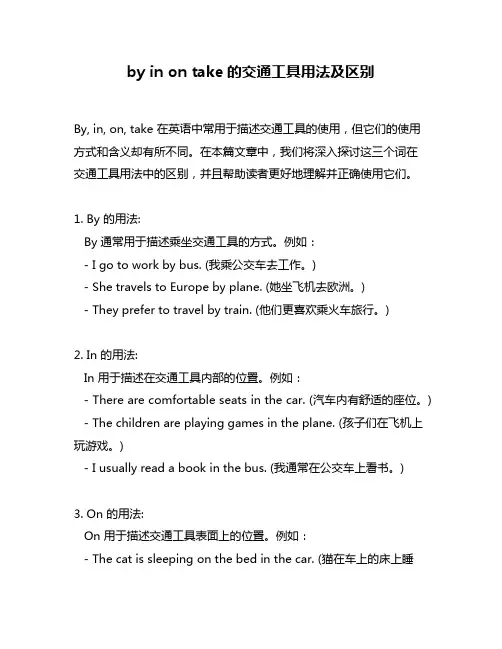
by in on take的交通工具用法及区别By, in, on, take 在英语中常用于描述交通工具的使用,但它们的使用方式和含义却有所不同。
在本篇文章中,我们将深入探讨这三个词在交通工具用法中的区别,并且帮助读者更好地理解并正确使用它们。
1. By 的用法:By 通常用于描述乘坐交通工具的方式。
例如:- I go to work by bus. (我乘公交车去工作。
)- She travels to Europe by plane. (她坐飞机去欧洲。
)- They prefer to travel by train. (他们更喜欢乘火车旅行。
)2. In 的用法:In 用于描述在交通工具内部的位置。
例如:- There are comfortable seats in the car. (汽车内有舒适的座位。
) - The children are playing games in the plane. (孩子们在飞机上玩游戏。
)- I usually read a book in the bus. (我通常在公交车上看书。
)3. On 的用法:On 用于描述交通工具表面上的位置。
例如:- The cat is sleeping on the bed in the car. (猫在车上的床上睡觉。
)- There is a blanket on her lap in the plane. (她的膝盖上有一条毯子。
)- He's standing on the platform waiting for the train. (他站在站台上等火车。
)4. Take 的用法:Take 表示搭乘或乘坐交通工具。
例如:- I take the subway to work every day. (我每天坐地铁上班。
)- She takes a taxi to the airport. (她坐出租车去机场。
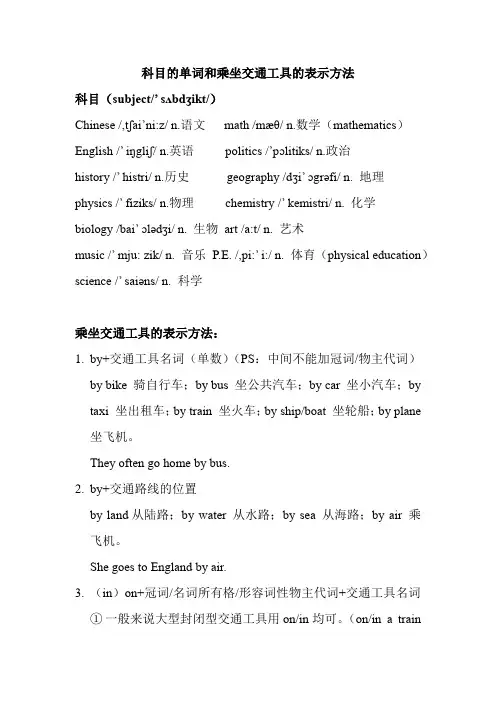
科目的单词和乘坐交通工具的表示方法科目(subject/’ sʌbdʒikt/)Chinese /,tʃai’ni:z/ n.语文math /mæθ/ n.数学(mathematics)English /’ iŋgliʃ/ n.英语politics /’pɔlitiks/ n.政治history /’ histri/ n.历史geography /dʒi’ ɔgrəfi/ n. 地理physics /’ fiziks/ n.物理chemistry /’ kemistri/ n. 化学biology /bai’ ɔlədʒi/ n. 生物art /a:t/ n. 艺术music /’ mju: zik/ n. 音乐P.E. /,pi:’ i:/ n. 体育(physical education)science /’ saiəns/ n. 科学乘坐交通工具的表示方法:1.by+交通工具名词(单数)(PS:中间不能加冠词/物主代词)by bike 骑自行车;by bus 坐公共汽车;by car 坐小汽车;by taxi 坐出租车;by train 坐火车;by ship/boat 坐轮船;by plane 坐飞机。
They often go home by bus.2.by+交通路线的位置by land从陆路;by water 从水路;by sea 从海路;by air 乘飞机。
She goes to England by air.3.(in)on+冠词/名词所有格/形容词性物主代词+交通工具名词①一般来说大型封闭型交通工具用on/in均可。
(on/in a train火车;on/in a plane飞机;on/in a ship轮船)②in:用于小型封闭型交通工具;不能站在或者骑在什么东西上,而必须坐在其中。
(in a car小汽车;in a taxi 出租车)③on: 用于非封闭型交通工具;表示骑在……上。
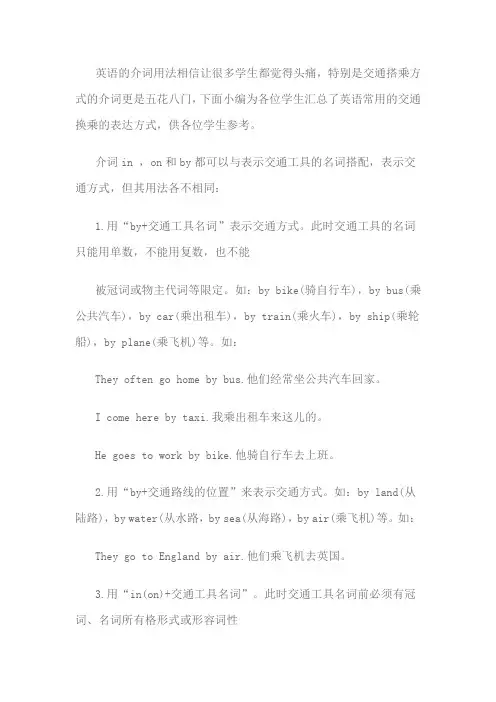
英语的介词用法相信让很多学生都觉得头痛,特别是交通搭乘方式的介词更是五花八门,下面小编为各位学生汇总了英语常用的交通换乘的表达方式,供各位学生参考。
介词in ,on和by都可以与表示交通工具的名词搭配,表示交通方式,但其用法各不相同:1.用“by+交通工具名词”表示交通方式。
此时交通工具的名词只能用单数,不能用复数,也不能被冠词或物主代词等限定。
如:by bike(骑自行车),by bus(乘公共汽车),by car(乘出租车),by train(乘火车),by ship(乘轮船),by plane(乘飞机)等。
如:They often go home by bus.他们经常坐公共汽车回家。
I come here by taxi.我乘出租车来这儿的。
He goes to work by bike.他骑自行车去上班。
2.用“by+交通路线的位置”来表示交通方式。
如:by land(从陆路),by water(从水路,by sea(从海路),by air(乘飞机)等。
如:They go to England by air.他们乘飞机去英国。
3.用“in(on)+交通工具名词”。
此时交通工具名词前必须有冠词、名词所有格形式或形容词性物主代词等限定词修饰。
其用法与“by+交通工具名词”相似。
如:He often goes to school on a(his)bike.他经常骑自行车去上学。
Don‘t come here on /in the ship.不要坐船来这里。
We go there in a car.我们乘小汽车去那里。
4.用“take a(the)+交通工具名词”表示交通方式。
如:take a bus(乘公共汽车),take atrain(乘火车),take a ship(乘轮船),take a plane(乘飞机);但“骑自行车”要用 ride abike来表示。
如:Will you take a bus to go there?你乘汽车去那儿吗?5.表示“步行去某地”,可用下列两种句式:(1)go to +某地+ on foot。
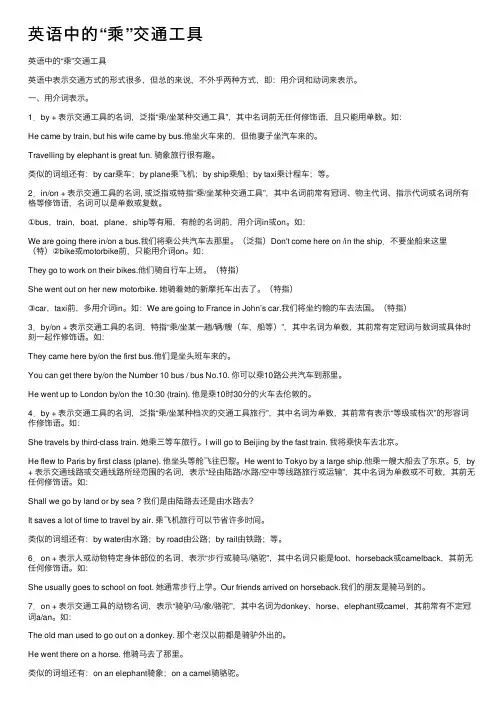
英语中的“乘”交通⼯具英语中的“乘”交通⼯具英语中表⽰交通⽅式的形式很多,但总的来说,不外乎两种⽅式,即:⽤介词和动词来表⽰。
⼀、⽤介词表⽰。
1.by + 表⽰交通⼯具的名词,泛指“乘/坐某种交通⼯具”,其中名词前⽆任何修饰语,且只能⽤单数。
如:He came by train, but his wife came by bus.他坐⽕车来的,但他妻⼦坐汽车来的。
Travelling by elephant is great fun. 骑象旅⾏很有趣。
类似的词组还有:by car乘车;by plane乘飞机;by ship乘船;by taxi乘计程车;等。
2.in/on + 表⽰交通⼯具的名词, 或泛指或特指“乘/坐某种交通⼯具”,其中名词前常有冠词、物主代词、指⽰代词或名词所有格等修饰语,名词可以是单数或复数。
①bus,train,boat,plane,ship等有厢,有舱的名词前,⽤介词in或on。
如:We are going there in/on a bus.我们将乘公共汽车去那⾥。
(泛指)Don't come here on /in the ship.不要坐船来这⾥(特)②bike或motorbike前,只能⽤介词on。
如:They go to work on their bikes.他们骑⾃⾏车上班。
(特指)She went out on her new motorbike. 她骑着她的新摩托车出去了。
(特指)③car,taxi前,多⽤介词in。
如:We are going to France in John’s car.我们将坐约翰的车去法国。
(特指)3.by/on + 表⽰交通⼯具的名词,特指“乘/坐某⼀趟/辆/艘(车,船等)”,其中名词为单数,其前常有定冠词与数词或具体时刻⼀起作修饰语。
如:They came here by/on the first bus.他们是坐头班车来的。
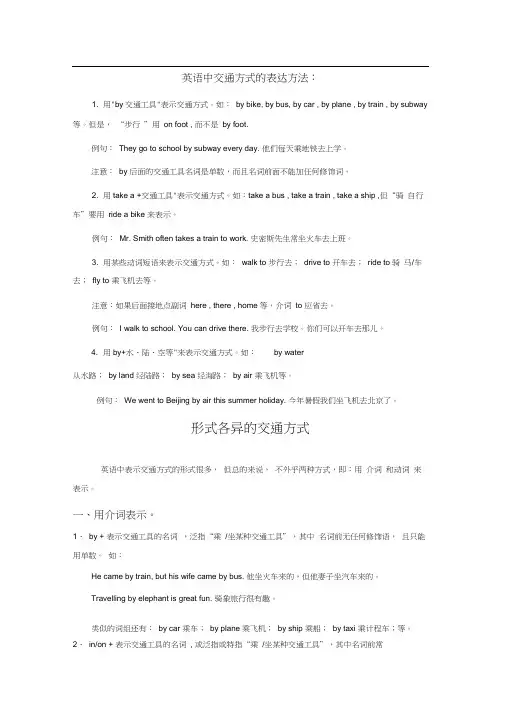
英语中交通方式的表达方法:1. 用"by交通工具"表示交通方式。
如:by bike, by bus, by car , by plane , by train , by subway 等。
但是,“步行”用on foot , 而不是by foot.例句:They go to school by subway every day. 他们每天乘地铁去上学。
注意:by 后面的交通工具名词是单数,而且名词前面不能加任何修饰词。
2. 用take a +交通工具"表示交通方式。
如:take a bus , take a train , take a ship ,但“骑自行车”要用ride a bike 来表示。
例句:Mr. Smith often takes a train to work. 史密斯先生常坐火车去上班。
3. 用某些动词短语来表示交通方式。
如:walk to 步行去;drive to 开车去;ride to 骑马/车去;fly to 乘飞机去等。
注意:如果后面接地点副词here , there , home 等,介词to 应省去。
例句:I walk to school. You can drive there. 我步行去学校。
你们可以开车去那儿。
4. 用by+水、陆、空等"来表示交通方式。
如:by water从水路;by land 经陆路;by sea 经海路;by air 乘飞机等。
例句:We went to Beijing by air this summer holiday. 今年暑假我们坐飞机去北京了。
形式各异的交通方式英语中表示交通方式的形式很多,但总的来说,不外乎两种方式,即:用介词和动词来表示。
一、用介词表示。
1.by + 表示交通工具的名词,泛指“乘/坐某种交通工具”,其中名词前无任何修饰语,且只能用单数。
如:He came by train, but his wife came by bus. 他坐火车来的,但他妻子坐汽车来的。
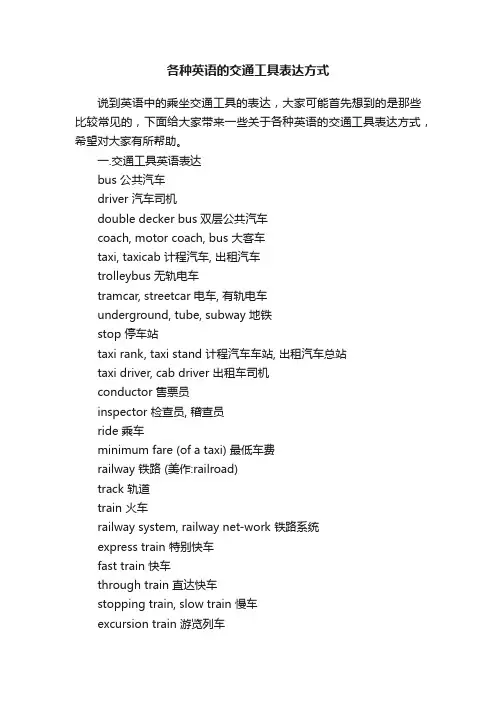
各种英语的交通工具表达方式说到英语中的乘坐交通工具的表达,大家可能首先想到的是那些比较常见的,下面给大家带来一些关于各种英语的交通工具表达方式,希望对大家有所帮助。
一.交通工具英语表达bus 公共汽车driver 汽车司机double decker bus 双层公共汽车coach, motor coach, bus 大客车taxi, taxicab 计程汽车, 出租汽车trolleybus 无轨电车tramcar, streetcar 电车, 有轨电车underground, tube, subway 地铁stop 停车站taxi rank, taxi stand 计程汽车车站, 出租汽车总站taxi driver, cab driver 出租车司机conductor 售票员inspector 检查员, 稽查员ride 乘车minimum fare (of a taxi) 最低车费railway 铁路 (美作:railroad)track 轨道train 火车railway system, railway net-work 铁路系统express train 特别快车fast train 快车through train 直达快车stopping train, slow train 慢车excursion train 游览列车commuter train, suburban train 市郊火车railcar 轨道车coach, carriage 车厢sleeping car, sleeper 卧车dining car, restaurant car, luncheon car 餐车sleeper with couchettes 双层卧铺车berth, bunk 铺位up train 上行车down train 下行车luggage van, baggage car 行李车mail car 邮政车station, railway station 车站station hall 车站大厅booking office, ticket office 售票处ticket-collector, gateman 收票员platform 月台, 站台platform ticket 站台票buffet 小卖部waiting room 候车室platform bridge 天桥left-luggage office 行李暂存处platform-ticket 验票门terminal, terminus 终点站coach, passenger train 客车car attendant, train attendant 列车员guard, conductor 列车长rack, baggage rack 行李架left-luggage office 行李房 (美作:checkroom) registration 登记timetable 时刻表change, transfer 换乘connection 公铁交接处ticket inspector 验票员porter 搬运工人to change trains at... 在(某地)换车the train is due at... 在(某时)到达to break the journey 中途下车boat, ship 船(passenger) liner 邮轮, 客轮sailing boat, sailing ship 帆船yacht 游船(ocean) liner 远洋班轮packet boat 定期客船, 班轮cabin 船舱hovercraft 气垫船life buoy 救生圈lifeboat 救生艇life jacket 救生衣berth, cabin, stateroom 客舱first-class stateroom (cabin) 头等舱second-class stateroom (cabin) 二等舱steerage, third-class 三等舱steerage 统舱gang-plank 跳板crossing 横渡cruise 游弋to embark, to ship 乘船to land 抵岸, to sail at a speed of 20 knots, 航速为20节to transship 换船to disembark 上岸to board a ship; to embark; to go aboard 上船to disembark from a ship, to go ashore, to land 下船on board a ship, aboard 在船上to stop over at... 中途在…停留civil aviation 民用航空plane, aircraft, airplane 飞机airliner 班机jet, supersonic plane 喷气机airliner, passenger aircraft 客机medium-haul aircraft 中程飞机long-range aircraft, long-haul aircraft 远程飞机propeller-driven aircraft 螺旋桨飞机jet (aircraft) 喷气飞机turbofan jet 涡轮风扇飞机turboprop 涡轮螺旋桨飞机turbojet 涡轮喷气飞机by air, by plane 乘飞机airline 航空线passenger cabin 客舱tourist class 普通舱, 经济舱first class 一等舱waiting list 登机票名单customs formalities 报关单boarding check 登机牌airport 航空港air terminal 航空集散站tarmac 停机坪air hostess, stewardess 空中小姐, 女乘务员steward 乘务员aircraft crew, air crew 机组, 机务人员pilot 驾驶员, 机长takeoff 起飞landing 着陆to board a plane, get into a plane 上飞机to get off a plane, alight from a plane 下飞机non-stop flight to 飞往, 直飞in transit 运送中的air pocket 气潭, 气阱二.交通工具乘坐方式表达1. I took a bus/train/plane/taxi/cab.句中的take不能换成ride,因为ride一般是指乘坐在该交通工具的顶部(on the top),比如骑马(ride a horse)或骑自行车(ride a bike)。
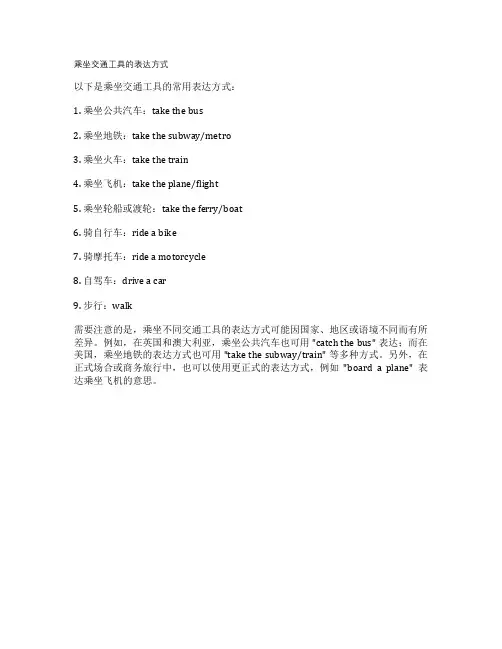
乘坐交通工具的表达方式
以下是乘坐交通工具的常用表达方式:
1. 乘坐公共汽车:take the bus
2. 乘坐地铁:take the subway/metro
3. 乘坐火车:take the train
4. 乘坐飞机:take the plane/flight
5. 乘坐轮船或渡轮:take the ferry/boat
6. 骑自行车:ride a bike
7. 骑摩托车:ride a motorcycle
8. 自驾车:drive a car
9. 步行:walk
需要注意的是,乘坐不同交通工具的表达方式可能因国家、地区或语境不同而有所差异。
例如,在英国和澳大利亚,乘坐公共汽车也可用 "catch the bus" 表达;而在美国,乘坐地铁的表达方式也可用 "take the subway/train" 等多种方式。
另外,在正式场合或商务旅行中,也可以使用更正式的表达方式,例如"board a plane" 表达乘坐飞机的意思。
乘坐交通工具有几种表达方式英语介词in ,on和by都可以与表示交通工具的名词搭配,表示交通方式,但其用法各不相同:1.用“by+交通工具名词”表示交通方式.此时交通工具的名词只能用单数,不能用复数,也不能被冠词或物主代词等限定.如:by bike (骑自行车),by bus(乘公共汽车),by car(乘出租车),by train (乘火车),by ship(乘轮船),by plane(乘飞机)等.如:They often go home by bus.他们经常坐公共汽车回家.I come here by taxi.我乘出租车来这儿的.He goes to work by bike.他骑自行车去上班.2.用“by+交通路线的位置”来表示交通方式.如:by land(从陆路),by water(从水路),by sea(从海路),by air(乘飞机)等.如:They go to England by air.他们乘飞机去英国.3.用“in(on)+交通工具名词”.此时交通工具名词前必须有冠词、名词所有格形式或形容词性物主代词等限定词修饰.其用法与“by+交通工具名词”相似.如:He often goes to school on a(his)bike.他经常骑自行车去上学.Don't come here on /in the ship.不要坐船来这里.We go there in a car.我们乘小汽车去那里.4.用“take a(the)+交通工具名词”表示交通方式.如:take a bus(乘公共汽车),take a train(乘火车),take a ship(乘轮船),take a plane(乘飞机);但“骑自行车”要用 ride a bike来表示.如:Will you take a bus to go there?你乘汽车去那儿吗?5.表示“步行去某地”,可用下列两种句式:(1)go to +某地+ on foot.如:She g oes to w ork on foot.她步行去上班.注意:on foot不可说成 on feet,on a /the /my foot,by foot等.(2)walk to +某地.如:He walks to school every day .=He goes to school on foot every day .他每天步行去上学.。
初中英语课外辅导:“乘坐”的讲究英语中表示"乘坐"交通工具的有两种词类,即介词的“乘”和动词的“乘”。
你得比较选用--1. by①by + 交通工具名词,表示“乘坐”。
如:by bus, by bike, by plane, by train, by car, by taxi, by ship等。
② by + 地理名词,表示“通过;由……途径”,此时表示旅行方式,而不涉及交通工具。
如:by sea (从海路),by air (由航空、坐飞机) 等。
【注意】在英语中,要表示乘坐某种交通工具可用by。
介词by表示“乘”时,其后可直接跟表示交通工具的名词,该名词前不能有代词或冠词修饰。
2. in,on介词in (on) + 冠词(形容词性物主代词等) + 交通工具名词也可表示“乘、坐”。
in多用于带舱或车厢的交通工具名词前,侧重于封闭式的交通工具;on 多用于开放式或半封闭式的交通工具。
如:They often go to the farm on a bike. 他们通常骑自行车去农场。
One day, you can go to the moon in a spaceship. 总有一天,你们可以乘宇宙飞船上月球。
【注意】骑自行车常用on a bike或by bike,而不能用in a bike。
骑马、骑骆驼等用on,如:on a horse, on the camel等。
在表示交通工具的名词前若有具体的时刻修饰时,则用介词by或on均可。
如:by (on) the 7:00 bus.3. take“take + 限定词(如a / the)+交通工具名词”也可表示“乘坐”。
如:You'd better take the No.3 bus to go there. 你最好乘3路公共汽车去那儿。
I go to school by bus every day. 我每天坐公共汽车上学。
英语中交通方式(de)表达方法:1. 用“by+交通工具”表示交通方式.如:by bike, by bus, by car , by plane , by train , by subway 等.但是,“步行”用on foot , 而不是by foot.例句:They go to school by subway every day.他们每天乘地铁去上学.注意:by后面(de)交通工具名词是单数,而且名词前面不能加任何修饰词.2. 用“take a +交通工具”表示交通方式.如:take a bus , take a train , take a ship , 但“骑自行车”要用ride a bike 来表示.例句:Mr. Smith often takes a train to work.史密斯先生常坐火车去上班.3. 用某些动词短语来表示交通方式.如:walk to 步行去;drive to 开车去;ride to骑马/车去;fly to乘飞机去等.注意:如果后面接地点副词here , there , home 等,介词to应省去.例句:I walk to school. You can drive there.我步行去学校.你们可以开车去那儿.4. 用“by+水、陆、空等”来表示交通方式.如:by water从水路;by land经陆路;by sea经海路;by air 乘飞机等.例句:We went to Beijing by air this summer holiday.今年暑假我们坐飞机去北京了.形式各异(de)交通方式英语中表示交通方式(de)形式很多,但总(de)来说,不外乎两种方式,即:用介词和动词来表示.一、用介词表示.1.by + 表示交通工具(de)名词,泛指“乘/坐某种交通工具”,其中名词前无任何修饰语,且只能用单数.如:He came by train, but his wife came by bus.他坐火车来(de),但他妻子坐汽车来(de).Travelling by elephant is great fun. 骑象旅行很有趣.类似(de)词组还有:by car乘车;by plane乘飞机;by ship乘船;by taxi乘计程车;等.2.in/on + 表示交通工具(de)名词 ,或泛指或特指“乘/坐某种交通工具”,其中名词前常有冠词、物主代词、指示代词或名词所有格等修饰语,名词可以是单数或复数.① bus, train, boat, plane, ship等有厢,有舱(de)名词前,用介词in或on. 如:We are going there in/on a bus.我们将乘公共汽车去那里.(泛指)Don't come here on /in the ship. 不要坐船来这里.(特指)② bike或motorbike前,只能用介词on. 如:They go to work on their bikes.他们骑自行车上班.(特指)She went out on her new motorbike. 她骑着她(de)新摩托车出去了.(特指)③ car,taxi前,多用介词in. 如:We are going to France in John’s car.我们将坐约翰(de)车去法国.(特指)3.by/on + 表示交通工具(de)名词,特指“乘/坐某一趟/辆/艘(车,船等)”,其中名词为单数,其前常有定冠词与数词或具体时刻一起作修饰语.如:They came here by/on the first bus.他们是坐头班车来(de).You can get there by/on the Number 10 bus / bus No.10. 你可以乘10路公共汽车到那里.He went up to London by/on the 10:30 (train). 他是乘10时30分(de)火车去伦敦(de).4.by + 表示交通工具(de)名词,泛指“乘/坐某种档次(de)交通工具旅行”,其中名词为单数,其前常有表示“等级或档次”(de)形容词作修饰语.如:She travels by third-class train. 她乘三等车旅行.I will go to Beijing by the fast train. 我将乘快车去北京.He flew to Paris by first class (plane). 他坐头等舱飞往巴黎.He went to Tokyo by a large ship.他乘一艘大船去了东京.5.by + 表示交通线路或交通线路所经范围(de)名词,表示“经由陆路/水路/空中等线路旅行或运输”,其中名词为单数或不可数,其前无任何修饰语.如:Shall we go by land or by sea 我们是由陆路去还是由水路去It saves a lot of time to travel by air. 乘飞机旅行可以节省许多时间.类似(de)词组还有:by water由水路;by road由公路;by rail由铁路;等.6.on + 表示人或动物特定身体部位(de)名词,表示“步行或骑马/骆驼”,其中名词只能是foot, horseback或 camelback, 其前无任何修饰语.如:She usually goes to school on foot. 她通常步行上学.Our friends arrived on horseback.我们(de)朋友是骑马到(de).7.on + 表示交通工具(de)动物名词,表示“骑驴/马/象/骆驼”,其中名词为donkey, horse, elephant或camel, 其前常有不定冠词a/an. 如:The old man used to go out on a donkey. 那个老汉以前都是骑驴外出(de).He went there on a horse. 他骑马去了那里.类似(de)词组还有:on an elephant骑象;on a camel骑骆驼.二、用动词表示.1.“动词 + to + 地点名词”或“动词 + 地点副词”. 这种动词主要是walk (步行),ride(骑车),drive(开车),fly(乘飞机),sail(乘船)等.如:I usually walk to school. 我通常步行上学.We sometimes ride to school. 我们有时骑车上学.They drove to the station. 他们开车去了车站.Jack flew there last Sunday. 杰克上星期乘飞机去那里了.We sailed across the Atlantic in five days.我们乘船用了五天(de)时间横渡大西洋.2.“take a/the + 表示交通工具(de)名词”,表示“乘/坐……”.如:Will you take a bus to go there 你乘汽车去那儿吗I took a taxi to the hospital. 我坐计程车到医院去了.Tom often takes the train to go to work. 汤姆常坐这趟火车上班.类似(de)表达还有:take a ship(乘轮船),take a plane(乘飞机)等.3.“ride a/an + bike,motorbike或表示交通工具(de)动物名词,表示“骑……”.如:I ride a bike to work every day. 我天天骑自行车上班.He came here riding a horse /an elephant. 他骑马/象来到了这里.4.“ride on/in + a/an + 表示交通工具(de)名词”,表示“乘/坐/骑……”.如:She gets sick when she rides in/on a bus. 她坐公共汽车时晕车.The boy liked to ride on a motorbike.那男孩喜欢骑摩托车.He often rides on an elephant to travel. 他常骑象旅行.类似(de)表达还有:ride in/on a ship/train/plane/boat等.辨析ride a bike着重动作;ride in/on a bike着重状态. 5.“have/take a ride in/on + 表示交通工具(de)名词”,表示“乘/坐/骑一下/次……”.如: Would you like to have/take a ride in my new car 你要不要坐坐我(de)新车Can I have/take a ride on your bike 我能骑一下你(de)自行车吗He let me have/take a ride on his camel. 他让我骑了一下他(de)骆驼.6.“go for a ride in/on + 表示交通工具(de)名词”,表示“乘/坐/骑……去兜风”.如:They went for a ride on their horses/bicycles.他们骑马/自行车去兜了一圈.Let’s go for a ride in the car/a car ride. 我们乘汽车去兜风吧.I went for a ride on my horse before breakfast. 早餐前我骑马出去遛了遛.巩固练习:I. 用by, in, on, take填空.1.—How do you go to school every day—____ bike.2.They will go to the cinema ____ bus.3.He went to the park ____ a car yesterday.4.Helen will go there ____ the 12:00 bus.5.Will you ____ the bus to Beijing tomorrowII. 就划线部分提问.1.Mr Green goes to the post office by bike.(对划线部分提问)2.Ann is going shopping on foot.(对划线部分提问)Keys:I: 1.By 2.by 3.in 4.on /by 5.TakeII: 1. How does Mr. Green go to the post office2. How is Ann going shopping出门在外,谁也离不开交通.水、陆、空,路路通,交通可是很方便哟不过,你可要学会灵活选用交通方式,不然,就不能准时到达目(de)地.下面为同学们重点谈谈常见(de)交通表达方式:[方式一] 用“by+交通工具名词”表示交通方式.此时交通工具(de)名词只能用单数,不能用复数,也不能被冠词或物主代词等修饰.如:by bike, by bus, by coach, by underground, by car, by train, by ship, by plane等.如:I came here by taxi. 我乘出租车来这儿(de).We can go to the zoo by coach or underground. 我们可以乘长途汽车或地铁去动物园.Simon often goes to school by bike. 西蒙经常骑自行车去上学.[方式二] 用“by+交通路线(de)位置”表示交通方式.如:by sea(=by ship), by air(=by plane)等.如:They usually go to England by air/ plane. 他们通常乘飞机去英国.I always go to London by sea/ship. 我总是乘船去伦敦.[方式三] 用“in(on)+交通工具名词”表示交通方式.此时交通工具名词前必须有冠词、名词所有格形式或形容词性物主代词等限定词修饰.如:Daniel often goes to school on a/his bike. 丹尼尔经常骑自行车去上学.Don’t come here on/in the ship. 不要坐船来这里.We go there in a car. 我们乘小汽车去那里.[方式四] 用“take a(the)+交通工具名词”表示交通方式.如:take a bus, take a train, take a ship, take a plane;但“骑自行车”用ride a bike表示;“乘飞机”也可用fly to表示;“乘(驾)小汽车”用drive a car表示.如:Will you take a bus to go there 你乘公共汽车去那儿吗Can you ride a bike to go there 你能骑自行车去那儿吗We will fly to Japan next week. 下周我们将乘飞机去日本.They will drive a car to the USA. 他们将乘小汽车去美国.[方式五] 表示“步行去某地”,可用下列两种句式:⑴go to+某地+on foot.如:She goes to work on foot. 她步行去上班.注意:on foot不可说成on feet, on a/the/my foot, by foot等.⑵walk to+某地.如:He walks to school every day. =He goes to school on foot every day. 他每天步行去上学.注意:a. walk不可与on foot连用.如上述例句不可说成:He walks to school on foot every day.b. walk to后接地点副词here, there, home时,介词to要省去.如:I usually walk home. 我通常步行回家.此外,同学们还应知道:我们在对交通方式提问时要用特殊疑问词how.如:Ann is going shopping on foot. (就划线部分提问)→How is Ann going shopping。
英语中交通方式的表达方法:1. 用“by+交通工具”表示交通方式.如:by bike,by bus, by car ,by plane , by train ,by subway 等。
但是,“步行”用on foot , 而不是by foot。
例句:They go to school by subway every day.他们每天乘地铁去上学。
注意:by后面的交通工具名词是单数,而且名词前面不能加任何修饰词。
2。
用“take a +交通工具”表示交通方式。
如:take a bus , take a train ,take a ship , 但“骑自行车"要用ride a bike 来表示。
例句:Mr. Smith often takes a train to work.史密斯先生常坐火车去上班.3. 用某些动词短语来表示交通方式。
如:walk to步行去;drive to开车去;ride to骑马/车去;fly to乘飞机去等。
注意:如果后面接地点副词here ,there ,home 等,介词to应省去。
例句:I walk to school. You can drive there。
我步行去学校。
你们可以开车去那儿。
4。
用“by+水、陆、空等”来表示交通方式。
如:by water从水路;by land经陆路;by sea经海路;by air乘飞机等。
例句:We went to Beijing by air this summer holiday.今年暑假我们坐飞机去北京了。
形式各异的交通方式英语中表示交通方式的形式很多,但总的来说,不外乎两种方式,即:用介词和动词来表示.一、用介词表示。
1.by + 表示交通工具的名词,泛指“乘/坐某种交通工具",其中名词前无任何修饰语,且只能用单数。
如:He came by train, but his wife came by bus。
河南省虞城县第一初级中学七年级英语下学期期末复习交通方式的表达方式人教新目标版1 、用“by+交通工具〞表示交通方式。
如:bybike,bybus,bycar,byplane,by train,bysubway 等。
但是,“步行〞用onfoot, 而不是byfoot.例句:Theygotoschoolby subwayeveryday.他们每天乘地铁去上学。
注意:by后面的交通工具名词是单数,而且名词前面不能加任何修饰词。
2 、用"takea+ 交通工具〞表示交通方式。
如:takeabus,takeatrain,takea ship, 但“骑自行车〞要用rideabike 来表示。
例句:Mr.Smithoftentakesatraintowork.史密斯先生常坐火车去上班。
、用某些动词短语来表示交通方式。
如:walkto:步行去;driveto:开车去;ride to: 骑马/车去;flyto: 乘飞机去等。
注意:如果后面接地点副词here,there,home 等,介词to应省去。
例句:Iwalktoschool.Youcandrivethere.我步行去学校。
你们可以开车去那儿。
4 、用"by+水、陆、空等〞来表示交通方式。
如:bywater:从水路;byland: 经陆路;bysea: 经海路;byair: 乘飞机等。
例句:Wewenttobeijingbyairthissummerho liday.今年暑假我们坐飞机去北京了。
形式各异的交通方式英语中表示交通方式的形式很多,但总的来说,不外乎两种方式,即:用介词和动词来表示。
一、用介词表示。
1.by+ 表示交通工具的名词,泛指“乘/坐某种交通工具〞,其中名词前无任何修饰语,且只能用单数。
如:Hecamebytrain,buthiswifecamebybus. 他坐火车来的,但他妻子坐汽车来的。
1Travellingbyelephantisgreatfun. 骑象旅行很有趣。